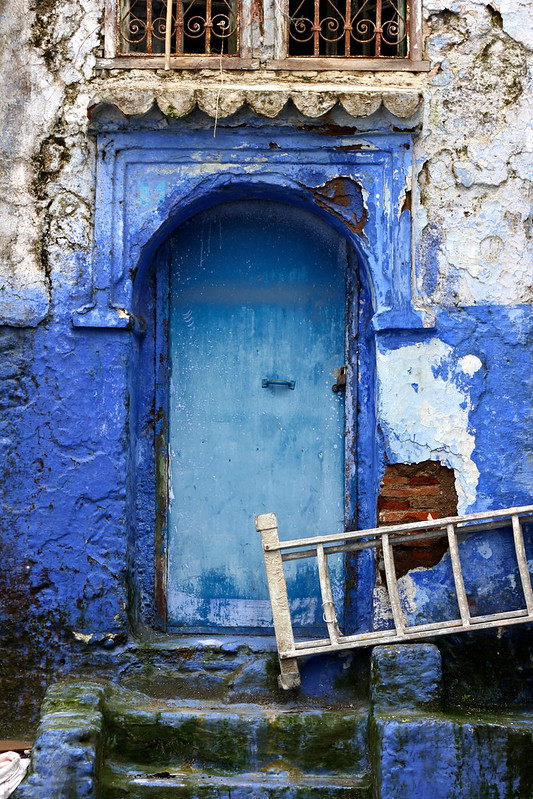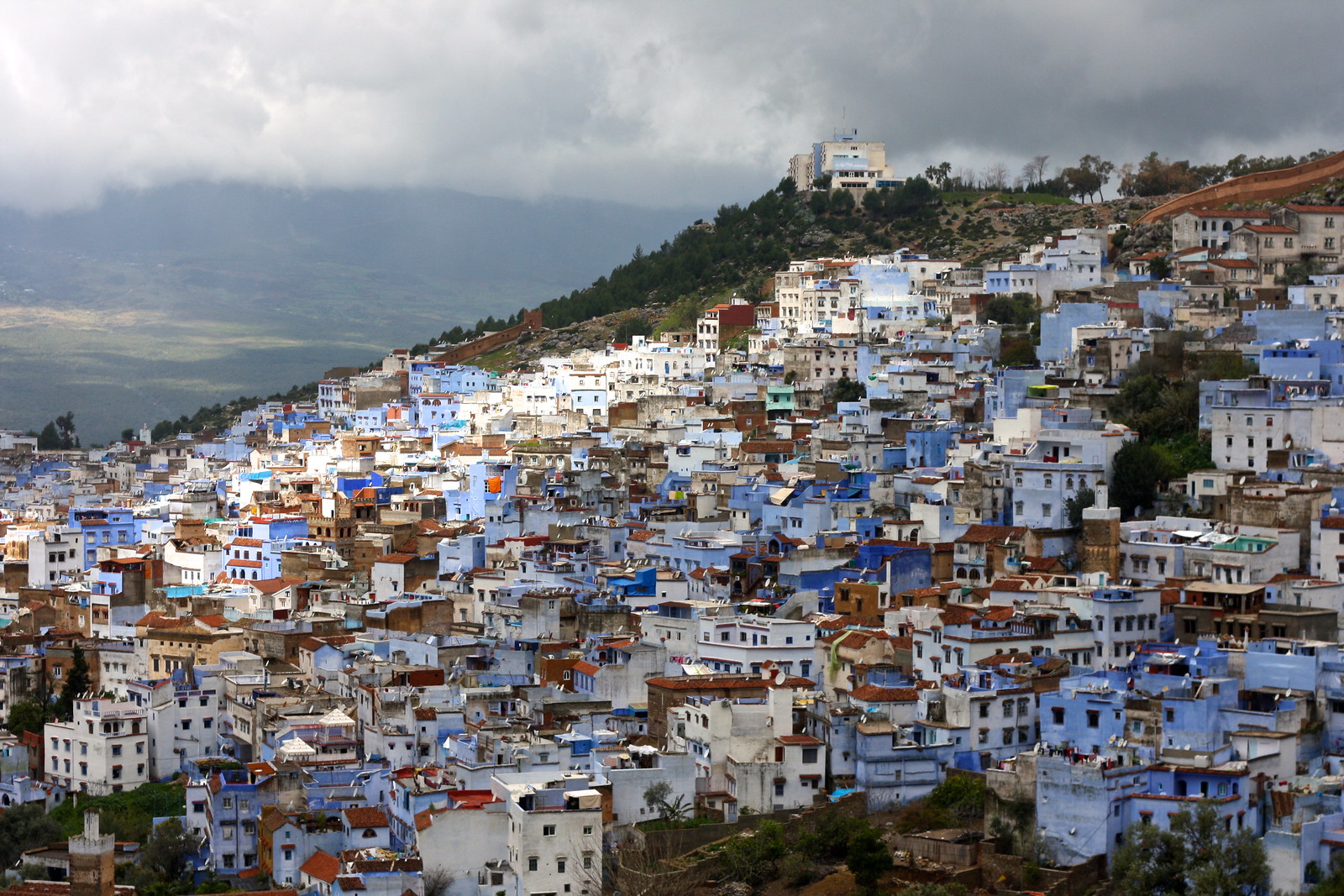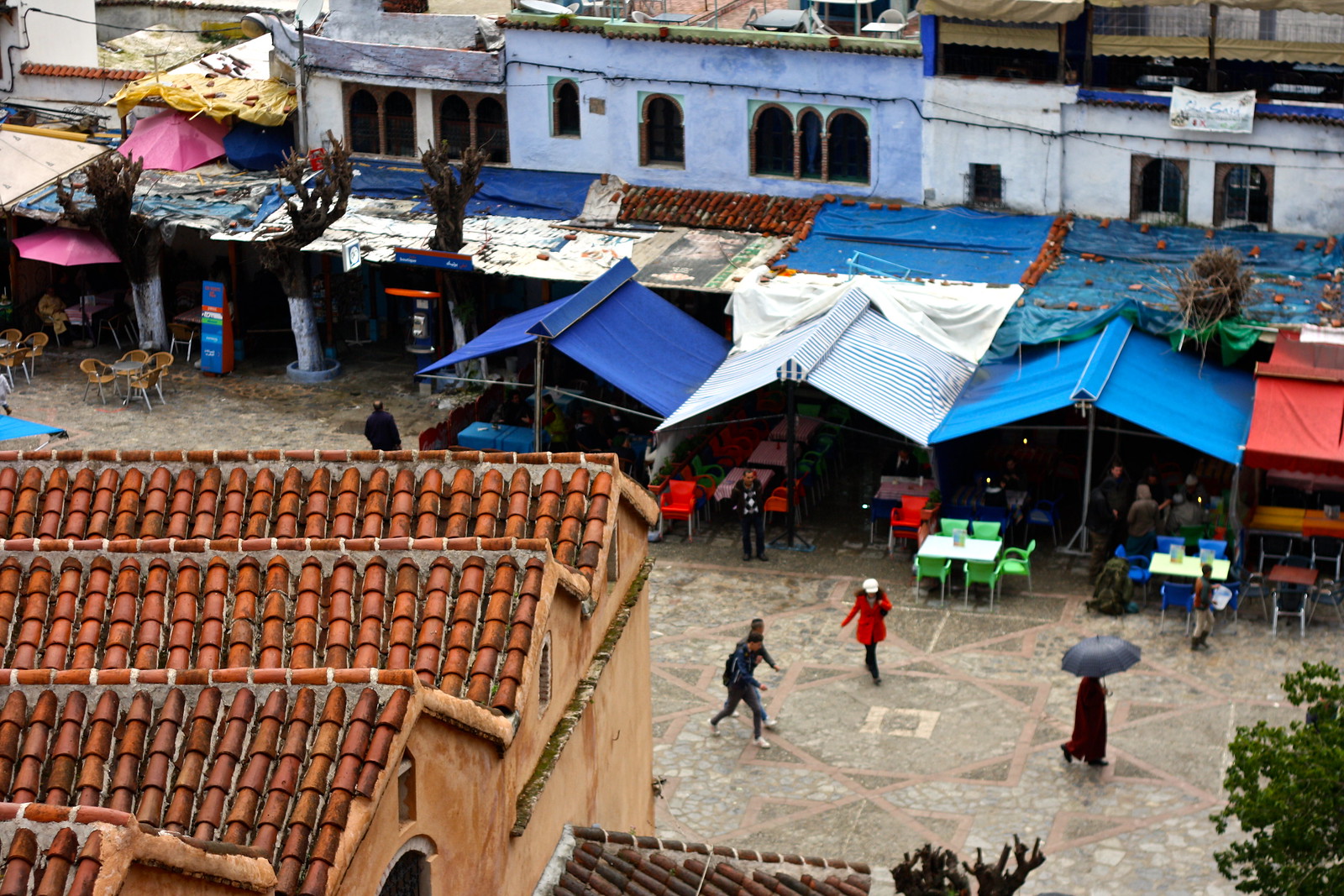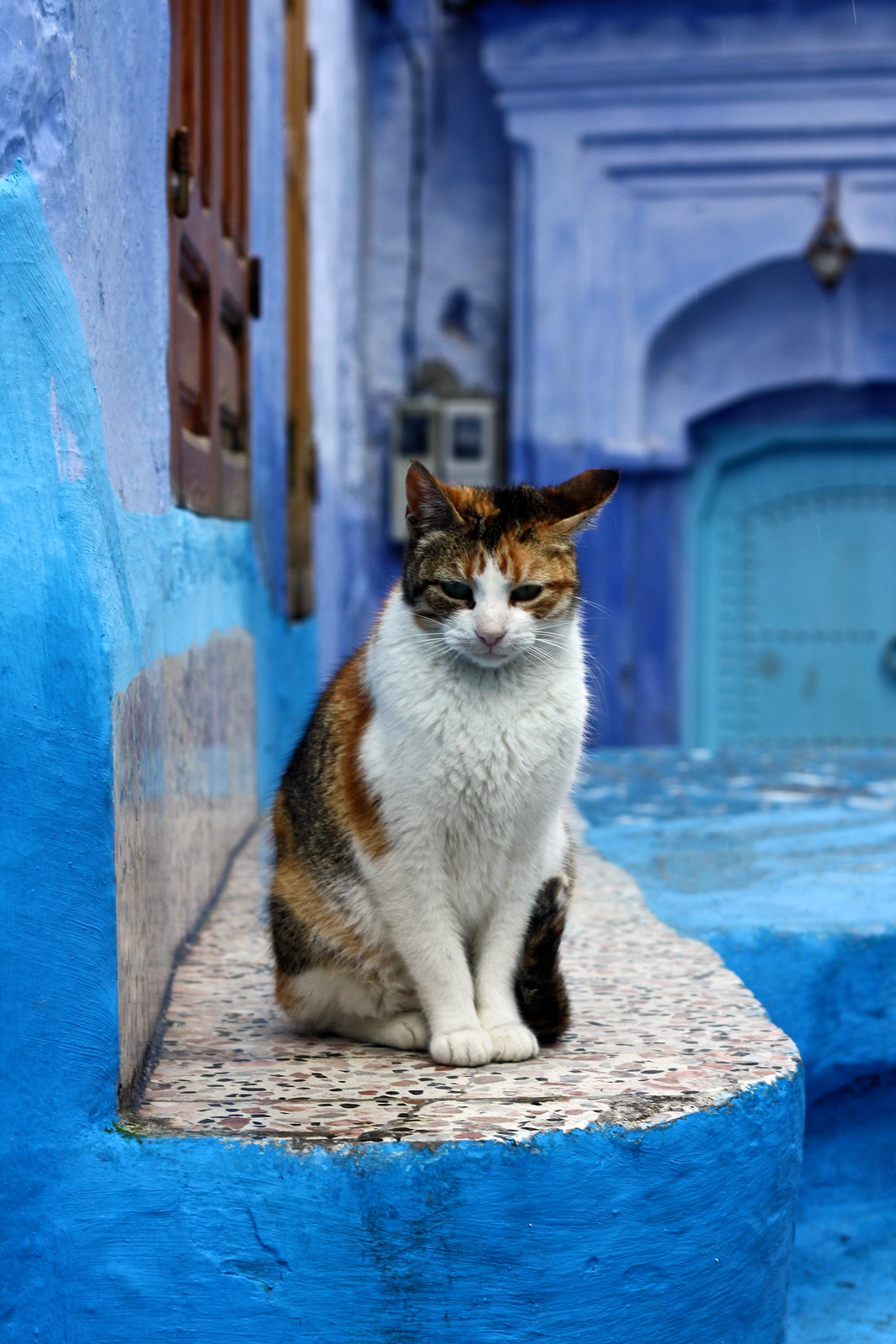Chefchaouen, Morocco: Photos of a Blue, Spanish-Style Town
To finish off a warm, spring week in Morocco this past March, I spent two nights in the city of Chefchaouen, a cozy place set on a hillside about an hour or so from the Mediterranean coast. While researching for the trip, I kept coming across stories and pictures of this town that made it seem like a fantasy world, painted all-blue everywhere. Blue is my favorite color, after all, and wandering through a city completely blue sounded super cool, so I put it on my list.
Pronounced “shuf-SHAH-wehn” [ʃəfˈʃɑ.wən], Chefchaouen was settled in 1471 as a military town to counter the Portuguese, who had been invading the region from the Mediterranean coast (think Ceuta). Because of this (and perhaps because of its location in the mountains), the town was hostile to non-Muslims up until the mid-20th century, when the Spanish came in and colonized the country.
Today, Chefchaouen is a fun and safe city to visit that welcomes tourists Muslim and non-Muslim alike. Its medina or medieval walled city is easy to get around; you won’t get nearly as lost here as you might in Fez or Marrakesh because Chefchaouen is much smaller and also on a hillside from where you can get some perspective. The general mood of the city is calm (perhaps it’s because of all the blue paint?), and a cool mountain river rushes by the southern limits of town, so ’Chaouen makes for a great place to recharge from the excitement of the imperial cities or the intensity of the desert.
In this post I’m going to present six of my favorite photographs from my stay here and do a little write-up beneath each one. Enjoy!
Sitting in front of the main mosque and the kasbah (fortress) is the town’s main plaza—yes, plaza, and not French place, because of the lingering Spanish influence. Even the new part of town is called ciudad nueva instead of ville nouvelle, and although I did have to speak to my hostel manager in French, Spanish was clearly the second language of choice here.
This square was clearly Tourist Central, but I really loved the atmosphere: people coming and going to the mosque, traders haggling over their wares, and waiters encouraging tourists to eat at their restaurants. A great evergreen tree in the center complements the brown stone fortress to the south nicely. Moroccan dads sit around tables and smoke, sip coffee, and chatter on in Arabic while quiet German tourists walk by, clad in bright synthetic clothes and discreetly talking to their partners.
In Arabic, the word medina (al-madinah) simply means “city,” but in Morocco, it refers to the old, medieval walled city with thousands of winding streets—in contrast with the gridded, Western-style new town built by the French or the Spanish during the colonial era, called either ville nouvelle or ciudad nueva. In the medinas, you find the traditional souks or markets where they sell food, clothing, and basically everything you can think of.
When I was in Fez, I was super intimidated by its massive, 9,000-street Medina, so I hired a private tour guide to take me through the city, but Chefchaouen’s old town was much more manageable. Even if you didn’t know where you were going, if you just kept walking in the same direction you’d end up on one of the main streets where all the shops and restaurants were and eventually wind up either outside the city walls or in the plaza. Plus, since Chefchaouen is on a hillside, you instantly know generally where you are, because up the stairs is north and down the hill is south.
The medina itself is where all the blue paint is at—the doors, walls, and stairs of all the homes crowding around the narrow streets are covered in some shade of blue, often with a white accent on the top.
The vast majority of the homes and buildings in the old medina were very well kept-up, with fresh coats of paint and sharp trims and borders. However, while strolling through town (read: getting lost), I came across this anonymous, not too-well-kept-up entrance and was struck at just how different it was from the rest of the homes around. The gradients of blues—the paint merging with dirt and mold, or layers of paint flaking away—made for a very interesting house, one perhaps just as beautiful as its clean, bright neighbors.
As I’ve said multiple times already, blue was everywhere! Often complemented with white or a lighter shade of blue, this characteristic color was all over the façades, the doors, the walls, and sometimes the footpaths. But to continue with the Spanish theme, the textured lower half and the whitewashed upper half of the walls was almost identical to those I’ve seen across the southern half of Spain; see this picture from Campo de Criptana as an example!
My Lonely Planet guide tells me that Jews and Muslims fleeing 100% Catholic Spain in 1494 came to live in Chefchaouen, bringing Spanish homebuilding traditions with them. In contrast with the typical Moroccan, windowless, courtyard-centered houses, the ones constructed by these refugees incorporated whitewashing and plenty of windows and balconies. Interestingly, the town was painted Islamic green until the 1930s, when the blue paint was introduced.
Every so often, I would come across a passageway or an alcove completely covered in plaster and blue paint. Sometimes it was just an arch, other times it was a tunnel beneath an overhanging bedroom, or it was a claustrophobic dead-end like the one in the photo above. In these rare concentrations of blue, I felt as if I were in a surreal movie, a fantasy video game, or a page from a Dr. Seuss book. Seeing the everyday Moroccan people just hanging out like it was normal made such settings all the more fascinating. Whenever I wasn’t eating or drinking tea, I spent most of my time walking around the medina, hiking up the stairs, looking for ethereal nooks and crannies like this one.
Stray cats were everywhere in Morocco, and they made no exception for Chefchaouen. I was walking through a quiet and empty part of town when I came across this lovely white-and-brown cat, just sitting there on a doorstep primly, if a little forlorn. I crept closer to get a decent shot of the cat—and it stayed there unafraid, almost as if posing.
Are there any other cities you can think of that are famous for going crazy with the same bucket of paint? What do you think of the photo-post format? Tell me what you think below in the comments!

 |
| City panorama |
Pronounced “shuf-SHAH-wehn” [ʃəfˈʃɑ.wən], Chefchaouen was settled in 1471 as a military town to counter the Portuguese, who had been invading the region from the Mediterranean coast (think Ceuta). Because of this (and perhaps because of its location in the mountains), the town was hostile to non-Muslims up until the mid-20th century, when the Spanish came in and colonized the country.
Today, Chefchaouen is a fun and safe city to visit that welcomes tourists Muslim and non-Muslim alike. Its medina or medieval walled city is easy to get around; you won’t get nearly as lost here as you might in Fez or Marrakesh because Chefchaouen is much smaller and also on a hillside from where you can get some perspective. The general mood of the city is calm (perhaps it’s because of all the blue paint?), and a cool mountain river rushes by the southern limits of town, so ’Chaouen makes for a great place to recharge from the excitement of the imperial cities or the intensity of the desert.
In this post I’m going to present six of my favorite photographs from my stay here and do a little write-up beneath each one. Enjoy!
1) Plaza Uta el-Hammam
 |
| Plaza Uta el-Hammam |
Sitting in front of the main mosque and the kasbah (fortress) is the town’s main plaza—yes, plaza, and not French place, because of the lingering Spanish influence. Even the new part of town is called ciudad nueva instead of ville nouvelle, and although I did have to speak to my hostel manager in French, Spanish was clearly the second language of choice here.
This square was clearly Tourist Central, but I really loved the atmosphere: people coming and going to the mosque, traders haggling over their wares, and waiters encouraging tourists to eat at their restaurants. A great evergreen tree in the center complements the brown stone fortress to the south nicely. Moroccan dads sit around tables and smoke, sip coffee, and chatter on in Arabic while quiet German tourists walk by, clad in bright synthetic clothes and discreetly talking to their partners.
2) The medina
 |
| Running errands in the medina |
In Arabic, the word medina (al-madinah) simply means “city,” but in Morocco, it refers to the old, medieval walled city with thousands of winding streets—in contrast with the gridded, Western-style new town built by the French or the Spanish during the colonial era, called either ville nouvelle or ciudad nueva. In the medinas, you find the traditional souks or markets where they sell food, clothing, and basically everything you can think of.
When I was in Fez, I was super intimidated by its massive, 9,000-street Medina, so I hired a private tour guide to take me through the city, but Chefchaouen’s old town was much more manageable. Even if you didn’t know where you were going, if you just kept walking in the same direction you’d end up on one of the main streets where all the shops and restaurants were and eventually wind up either outside the city walls or in the plaza. Plus, since Chefchaouen is on a hillside, you instantly know generally where you are, because up the stairs is north and down the hill is south.
The medina itself is where all the blue paint is at—the doors, walls, and stairs of all the homes crowding around the narrow streets are covered in some shade of blue, often with a white accent on the top.
3) Textures
 |
| A fading paint job |
The vast majority of the homes and buildings in the old medina were very well kept-up, with fresh coats of paint and sharp trims and borders. However, while strolling through town (read: getting lost), I came across this anonymous, not too-well-kept-up entrance and was struck at just how different it was from the rest of the homes around. The gradients of blues—the paint merging with dirt and mold, or layers of paint flaking away—made for a very interesting house, one perhaps just as beautiful as its clean, bright neighbors.
4) The color scheme
 |
| Mark Rothko-style photograph: White and Blue |
As I’ve said multiple times already, blue was everywhere! Often complemented with white or a lighter shade of blue, this characteristic color was all over the façades, the doors, the walls, and sometimes the footpaths. But to continue with the Spanish theme, the textured lower half and the whitewashed upper half of the walls was almost identical to those I’ve seen across the southern half of Spain; see this picture from Campo de Criptana as an example!
My Lonely Planet guide tells me that Jews and Muslims fleeing 100% Catholic Spain in 1494 came to live in Chefchaouen, bringing Spanish homebuilding traditions with them. In contrast with the typical Moroccan, windowless, courtyard-centered houses, the ones constructed by these refugees incorporated whitewashing and plenty of windows and balconies. Interestingly, the town was painted Islamic green until the 1930s, when the blue paint was introduced.
5) Doorways
 |
| Spaceship-style passageway |
Every so often, I would come across a passageway or an alcove completely covered in plaster and blue paint. Sometimes it was just an arch, other times it was a tunnel beneath an overhanging bedroom, or it was a claustrophobic dead-end like the one in the photo above. In these rare concentrations of blue, I felt as if I were in a surreal movie, a fantasy video game, or a page from a Dr. Seuss book. Seeing the everyday Moroccan people just hanging out like it was normal made such settings all the more fascinating. Whenever I wasn’t eating or drinking tea, I spent most of my time walking around the medina, hiking up the stairs, looking for ethereal nooks and crannies like this one.
6) Cats
 |
| Chefchaouen chat |
Stray cats were everywhere in Morocco, and they made no exception for Chefchaouen. I was walking through a quiet and empty part of town when I came across this lovely white-and-brown cat, just sitting there on a doorstep primly, if a little forlorn. I crept closer to get a decent shot of the cat—and it stayed there unafraid, almost as if posing.
Are there any other cities you can think of that are famous for going crazy with the same bucket of paint? What do you think of the photo-post format? Tell me what you think below in the comments!

